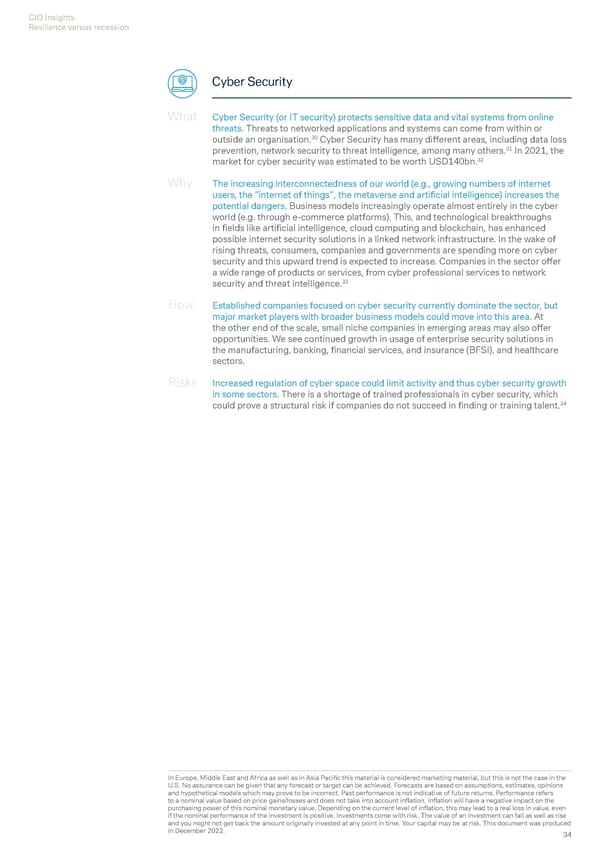CIO Insights Resilience versus recession Cyber Security What Cyber Security (or IT security) protects sensitive data and vital systems from online threats. Threats to networked applications and systems can come from within or 30 outside an organisation. Cyber Security has many different areas, including data loss 31 prevention, network security to threat intelligence, among many others. In 2021, the market for cyber security was estimated to be worth USD140bn.32 Why The increasing interconnectedness of our world (e.g., growing numbers of internet users, the “internet of things”, the metaverse and artificial intelligence) increases the potential dangers. Business models increasingly operate almost entirely in the cyber world (e.g. through e-commerce platforms). This, and technological breakthroughs in fields like artificial intelligence, cloud computing and blockchain, has enhanced possible internet security solutions in a linked network infrastructure. In the wake of rising threats, consumers, companies and governments are spending more on cyber security and this upward trend is expected to increase. Companies in the sector offer a wide range of products or services, from cyber professional services to network security and threat intelligence.33 How Established companies focused on cyber security currently dominate the sector, but major market players with broader business models could move into this area. At the other end of the scale, small niche companies in emerging areas may also offer opportunities. We see continued growth in usage of enterprise security solutions in the manufacturing, banking, financial services, and insurance (BFSI), and healthcare sectors. Risks Increased regulation of cyber space could limit activity and thus cyber security growth in some sectors. There is a shortage of trained professionals in cyber security, which 34 could prove a structural risk if companies do not succeed in finding or training talent. In Europe, Middle East and Africa as well as in Asia Pacific this material is considered marketing material, but this is not the case in the U.S. No assurance can be given that any forecast or target can be achieved. Forecasts are based on assumptions, estimates, opinions and hypothetical models which may prove to be incorrect. Past performance is not indicative of future returns. Performance refers to a nominal value based on price gains/losses and does not take into account inflation. Inflation will have a negative impact on the purchasing power of this nominal monetary value. Depending on the current level of inflation, this may lead to a real loss in value, even if the nominal performance of the investment is positive. Investments come with risk. The value of an investment can fall as well as rise and you might not get back the amount originally invested at any point in time. Your capital may be at risk. This document was produced in December 2022. 34
 Deutsche Bank Economic and Investment Outlook Page 35 Page 37
Deutsche Bank Economic and Investment Outlook Page 35 Page 37